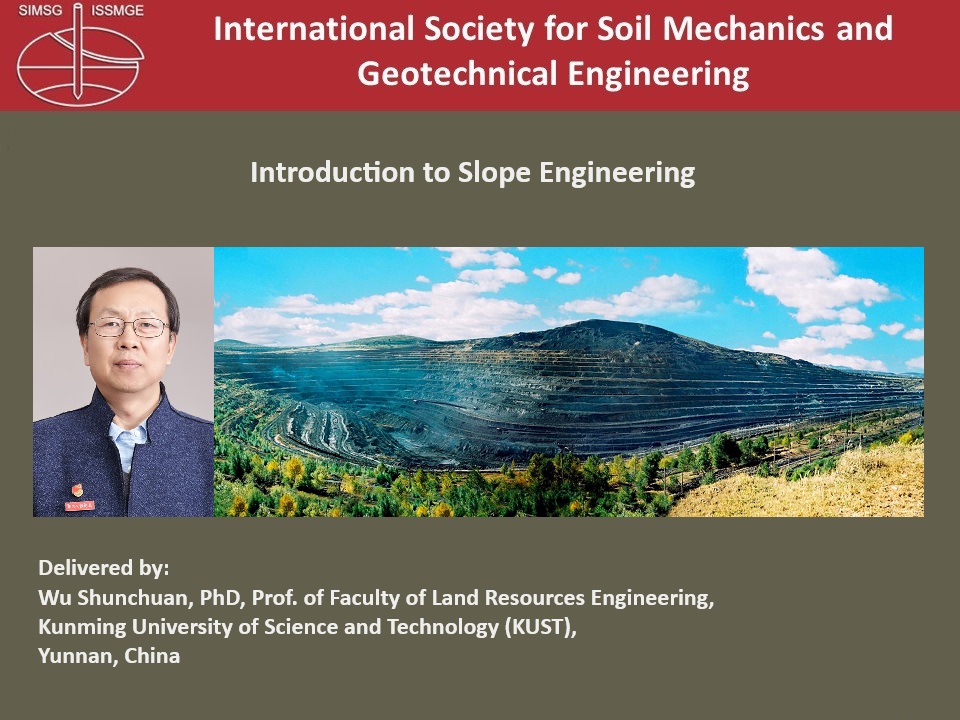
Prof. Wu Shunchuan, PhD, Faculty of Land Resources Engineering, Kunming University of Science and Technology (KUST), Yunnan, China
WU Shunchuan, a Professor of Faculty of Land Resources Engineering, Kunming University of Science and Technology (KUST), Yunnan, China, obtained his BSc degree of Mining Engineering from KUST (formerly called Kunming Institute of Technology) in 1990, and MSc and PhD degrees of Engineering Mechanics from University of Science and Technology Beijing in 1993 and 2004, respectively.
Currently he holds concurrent post as the chief of Key Laboratory of Geohazard Forecast and Geoecological Restoration in Plateau Mountainous Area, Ministry of Natural Resources, P.R. China, a research fellow of Chinese Society for Rock Mechanics and Engineering (CSRME), a vice director of Open-pit Mining and Slope Engineering Technical Committee of CSRME, a vice president of Chinese Sub-Society for Soft Rock & Deep Disaster Control. He is editorial board members of Chinese Journal of Rock Mechanics and Engineering and International Journal of Minerals, Metallurgy and Materials.
His research focuses on the disaster mechanism, monitoring and control of slope engineering and excavation of underground space. He established the Engineering Excavation Disaster-Causing Theory and Prevention-Control Technology. His theory laid a theoretical foundation for rock engineering disaster monitoring, warning and control, and was published in prestigious international journals such as Rock Mechanics and Rock Engineering, Engineering Geology, Computers and Geotechnics. He has also addressed himself to some practical issues in the safety control for the whole process of underground engineering excavation and operation, thereby gained many technology achievements which have become the common methods of engineering disaster treatment.
He won two National Science and Technology Progress Awards of China in 2003 and 2012 respectively for his research on the disaster prevention-control of underground engineering and highway engineering. He was recently given the 2022 Natural Science Award of CSRME for his outstanding contribution to the theory and method research on the complex fracture mechanism of rock and the catastrophic prediction.


![Decompose, Recompose: Useful approaches for the design of geotechnical structures (in French) {"category":"webinar","subjects":["Soil Structure Interaction", "Foundation Design/Construction", "Numerical and Constitutive Modelling"],"number":"CFMS-02","instructors":["Bruno Simon"]}](/asset-v1:ISSMGE+CFMS-02+2025+type@asset+block@webinar2.png)
![Intelligent Compaction {"category":"webinar","subjects":["Ground Improvement", "Soil Mechanics"],"number":"GI102","instructors":["Antonio Correia","George Chang"]}](/asset-v1:ISSMGE+GI102+2011+type@asset+block@pic5.jpg)
![Zelazny Most Copper Tailings Depository Numerical Analysis of Deep Vertical Shafts (First Tschebotarioff Lecture) {"category":"honour_lecture","subjects":["Mining", "Numerical and Constitutive Modelling"],"number":"HTL101","instructors":["Michele Jamiolkowski"]}](/asset-v1:ISSMGE+HTL101+2014+type@asset+block@htl101.jpg)
![Modelling and Testing (Bishop Lecture - 19th ICSMGE) {"category":"honour_lecture","subjects":["Laboratory Testing", "Numerical and Constitutive Modelling"],"number":"ICSMGE102","instructors":["David Muir Wood"]}](/asset-v1:ISSMGE+ICSMGE102+2017+type@asset+block@bishop-lecture.jpg)
![Role of the Soil-Water Characteristic Curve in Unsaturated Soil Mechanics (Geoffrey Blight Lecture - 19th ICSMGE) {"category":"honour_lecture","subjects":["Soil Mechanics"],"number":"ICSMGE19106","instructors":["Delwyn G. Fredlund"]}](/asset-v1:ISSMGE+ICSMGE19106+2017+type@asset+block@geoffrey-blight-lecture.jpg)
![On the Fabric and State Parameters of Active Clays for Contaminant Control (R. K. Rowe Lecture - 19th ICSMGE) {"category":"honour_lecture","subjects":["Contaminant Transport", "Soil Mechanics"],"number":"ICSMGE19114","instructors":["Mario Manassero"]}](/asset-v1:ISSMGE+ICSMGE19114+2017+type@asset+block@rowe-lecture.jpg)
![Numerical modelling in Geomechanics {"category":"webinar","subjects":["Numerical and Constitutive Modelling"],"number":"TC103-03","instructors":["T. Noda","H. Schweigher","F. Nicot","J. McCartney"]}](/asset-v1:ISSMGE+NM101+2022+type@asset+block@numerical-modelling-geomechanics.jpg)
![An Introduction to Numerical Modelling in Geotechnical Engineering {"category":"webinar","subjects":["Numerical and Constitutive Modelling"],"number":"NSM101","instructors":["Helmut F. Schweiger"]}](/asset-v1:ISSMGE+NSM101+2017+type@asset+block@Schweiger-Intro.jpg)
![Soil Behaviour {"category":"course","subjects":["Soil Mechanics"],"number":"SB-101","instructors":["Fumio Tatsuoka", "Eduardo Alonso", "Pierre Delage"]}](/asset-v1:ISSMGE+SB-101+2021+type@asset+block@cover.jpg)
![Unsaturated Soils: Basic Concepts and Applications (Part 1 and Part 2) {"category":"webinar","subjects":["Soil Mechanics"],"number":"SM101","instructors":["Eduardo Alonso"]}](/asset-v1:ISSMGE+SM101+2012+type@asset+block@pic3.jpg)
![Soil Characterisation {"category":"course","subjects":["Soil Mechanics","In-situ Testing","Residual Soils","Settlements","Laboratory Testing"],"number":"VU-SC","instructors":["Cor Zwanenburg","Samuel Kofi Ampadu","Gabriel Auvinet","Serge Leroueil","Richard Jardine"]}](/asset-v1:ISSMGE+TC102-002+2017+type@asset+block@Leroueil-small.jpg)
![From Discrete to Continuum: Multiscale Approach of Failure in Geomaterials {"category":"webinar","subjects":["Numerical and Constitutive Modelling"],"number":"TC103-01","instructors":["Francois Nicot"]}](/asset-v1:ISSMGE+TC103-01+2021+type@asset+block@Nicot-cover.jpg)
![Numerical Simulations on Energy Piles {"category":"webinar","subjects":["Numerical and Constitutive Modelling"],"number":"TC103-02","instructors":["John McCartney"]}](/asset-v1:ISSMGE+TC103-02+2021+type@asset+block@Screenshot_2024-05-14_143023.png)
![Performance assessment of soils and structures by numerical analysis {"category":"webinar","subjects":["Numerical and Constitutive Modelling"],"number":"TC103-03","instructors":["Toshihiro NODA"]}](/asset-v1:ISSMGE+TC103-03+2021+type@asset+block@cover.jpg)
![Numerical Simulation of Soft Soil Improvement Using Prefabricated Vertical Drains and Preloading {"category":"webinar","subjects":["Numerical and Constitutive Modelling"],"number":"TC103-04","instructors":["Ali Parsa-Pajouh"]}](/asset-v1:ISSMGE+TC103-04+2025+type@asset+block@photo.png)
![Undergraduate teaching of Unsaturated Soil Mechanics: Building on fundamental physical mechanisms to pave the way for geotechnical analyses {"category":"talk","subjects":["Teaching Geotechnics", "Soil Mechanics"],"number":"TC306-GEE2025-05","instructors":["Alessandro Tarantino", "Alessia Amabile"]}](/asset-v1:ISSMGE+TC306-GEE2025-05+2025+type@asset+block@tarantino-amabile.png)
![Unsaturated Soil Mechanics {"category":"course","subjects":["Soil Mechanics","Groundwater Flow & Seepage","Shear Strength of Ground Materials","Settlements"],"number":"VU-USM","instructors":["Delwyn G. Fredlund"]}](/asset-v1:Delwyn-G-Fredlund+Unsaturated-Soil-Mechanics+2019+type@asset+block@Introduction-to-Unsaturated-Soil-Mechanics.jpg)
![Risk-Mitigation, Monitoring & Observational Methods {"category":"course","subjects":["Risk and Reliability","Foundation Design Construction","Leeves","Erosion","Instrumentation","Landslides","Deep Excavations","Earth Retaining Structures","Numerical and Constitutive Modelling"],"number":"VU-RMOM","instructors":["Jean-Louis Briaud","Zenon Medina-Cetina","Marco Uzielli","An Bing Huang","Marc Ballouz"]}](/asset-v1:ISSMGE+VU-002+2016+type@asset+block@ballouz-webinar.jpg)